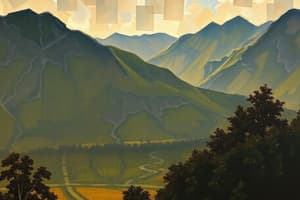Podcast
Questions and Answers
What is the main focus of physical geography?
What is the main focus of physical geography?
- Understanding weather patterns and temperature variations (correct)
- Exploring cultural features of the Earth
- Studying human population distribution
- Analyzing urbanization patterns
Which of the following is NOT a key aspect of physical geography?
Which of the following is NOT a key aspect of physical geography?
- Topography
- Hydrology
- Demography (correct)
- Geology
How does physical geography impact human populations?
How does physical geography impact human populations?
- By understanding the distribution of water resources (correct)
- By analyzing urbanization patterns
- By exploring human migration patterns
- By studying cultural features of the Earth
In physical geography, what does 'topography' refer to?
In physical geography, what does 'topography' refer to?
What does physical geography help us understand about the natural world?
What does physical geography help us understand about the natural world?
Which aspect of human geography focuses on the study of how human populations interact with the physical environment?
Which aspect of human geography focuses on the study of how human populations interact with the physical environment?
How does human geography help in planning for future infrastructure needs and resource management?
How does human geography help in planning for future infrastructure needs and resource management?
Which branch of geography involves the study of how human populations engage in economic activities such as agriculture, industry, and trade?
Which branch of geography involves the study of how human populations engage in economic activities such as agriculture, industry, and trade?
What is the primary focus of political geography?
What is the primary focus of political geography?
How does the study of physical geography contribute to our understanding of the world?
How does the study of physical geography contribute to our understanding of the world?
Flashcards
Geography
Geography
The study of the Earth's physical and cultural features.
Physical Geography
Physical Geography
The branch of geography focused on the Earth's natural features.
Topography
Topography
The study of the Earth's surface features.
Climate
Climate
Signup and view all the flashcards
Geology
Geology
Signup and view all the flashcards
Hydrology
Hydrology
Signup and view all the flashcards
Human Geography
Human Geography
Signup and view all the flashcards
Population Dynamics
Population Dynamics
Signup and view all the flashcards
Cultural Landscapes
Cultural Landscapes
Signup and view all the flashcards
Economic Geography
Economic Geography
Signup and view all the flashcards
Study Notes
Geography: Exploring the World's Physical and Cultural Landscapes
Geography is a field of study that focuses on the physical and cultural features of the Earth, including its landforms, bodies of water, climate, and human populations. It is divided into two main branches: physical geography and human geography. In this article, we will explore the fascinating world of geography, focusing on the subtopics of physical geography and human geography.
Physical Geography
Physical geography is the study of the Earth's natural features, such as mountains, oceans, rivers, lakes, and weather patterns. Some key aspects of physical geography include:
- Topography: The study of the Earth's surface features, such as mountains, valleys, and plateaus.
- Climate: The study of weather patterns and temperature variations in different regions of the world.
- Geology: The study of the Earth's structure, including the composition and properties of rocks and minerals.
- Hydrology: The study of water resources, including the movement and distribution of water on Earth.
Physical geography helps us understand the natural world around us and how it impacts human populations. For example, understanding the distribution of water resources can help us plan and manage water usage for agriculture and other essential human needs.
Human Geography
Human geography, also known as cultural geography, focuses on the study of human populations and their cultural, economic, and political characteristics. Some key aspects of human geography include:
- Population Dynamics: The study of human population growth, distribution, and migration patterns.
- Cultural Landscapes: The study of how human populations interact with the physical environment and create unique cultural landscapes.
- Economic Geography: The study of how human populations engage in economic activities, such as agriculture, industry, and trade.
- Political Geography: The study of how human populations are organized into political units, such as countries and regions.
Human geography helps us understand the complex relationships between human populations and the physical environment. For example, understanding population growth patterns can help us plan for future infrastructure needs and resource management.
Conclusion
Geography is a fascinating field of study that helps us understand the world around us, both in terms of its physical features and the way human populations interact with it. By studying physical geography, we can better appreciate the natural wonders of our planet, while human geography helps us understand the diverse cultures and societies that make up our global community. Together, these branches of geography provide valuable insights into our world and its intricate relationships.
Studying That Suits You
Use AI to generate personalized quizzes and flashcards to suit your learning preferences.




